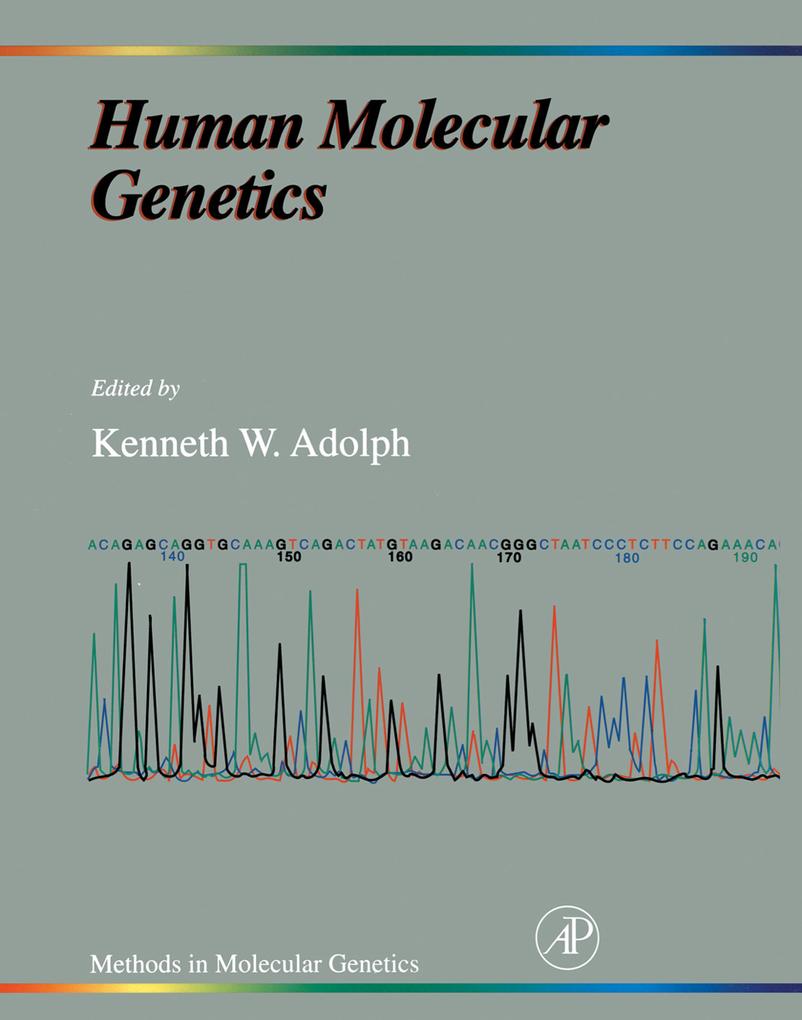Bücher versandkostenfrei*100 Tage RückgaberechtAbholung in der Wunschfiliale
15% Rabatt11 auf ausgewählte eReader & tolino Zubehör mit dem Code TOLINO15
Jetzt entdecken
mehr erfahren
Sofort lieferbar (Download)
Human Molecular Genetics is a practical guide to the applications of molecular biology and genetics techniques to human cells. A wide range of experimental procedures for investigating human genes and genomes are presented.
*
* Mutation Detection in Human Genes - chemical mismatch cleavage, DNA mini-sequencing, SSCP method, RT-PCR, electrophoretic mobility shift assay (EMSA), protein truncation test, chromosome deletion analysis.
* Gene Mapping, Cloning, Sequencing - gene linkage determination, large-capacity cloning system, cDNA isolation, differential display method, primer-based DNA sequencing.
* Transcription: Promoters, Transcription Factors, mRNA, - promotor mutation analysis, transcription factor identification, mRNA-protein interaction characterization.
* RNA Editing, Ribozymes, Antisense RNA-mammalian RNA editing assays, ribozymes as genetic tools, antisense RNA technology.
* Genome Recombination, Amplification - recombination assays for mammalian cells, gene amplification measurement.
* Receptors, Signal Transduction - intra-cellular receptor characterization, analysis of signal transduction genes.
* The Mouse as a Model System for Human Molecular Genetics - mouse genome methods (mouse crosses, somatic cell hybrids, YACs), mouse model for cardiovascular disease.
*
* Mutation Detection in Human Genes - chemical mismatch cleavage, DNA mini-sequencing, SSCP method, RT-PCR, electrophoretic mobility shift assay (EMSA), protein truncation test, chromosome deletion analysis.
* Gene Mapping, Cloning, Sequencing - gene linkage determination, large-capacity cloning system, cDNA isolation, differential display method, primer-based DNA sequencing.
* Transcription: Promoters, Transcription Factors, mRNA, - promotor mutation analysis, transcription factor identification, mRNA-protein interaction characterization.
* RNA Editing, Ribozymes, Antisense RNA-mammalian RNA editing assays, ribozymes as genetic tools, antisense RNA technology.
* Genome Recombination, Amplification - recombination assays for mammalian cells, gene amplification measurement.
* Receptors, Signal Transduction - intra-cellular receptor characterization, analysis of signal transduction genes.
* The Mouse as a Model System for Human Molecular Genetics - mouse genome methods (mouse crosses, somatic cell hybrids, YACs), mouse model for cardiovascular disease.
Inhaltsverzeichnis
1;Front Cover;1 2;Human Molecular Genetics;4 3;Copyright Page;5 4;Table of Contents;6 5;Contributors to Volume 8;10 6;Preface;16 7;Volumes in Series;18 8;Section I: Mutation Detection in Human Genes;20 8.1;Chapter 1. Chemical Mismatch Cleavage;22 8.2;Chapter 2. Detection of Point Mutations by Solid-Phase Minisequencing;33 8.3;Chapter 3. Simple and Nonisotopic Methods to Detect Unknown Gene Mutations in Nucleic Acids;45 8.4;Chapter 4. Identification and Functional Analysis of Mutations in Human PAX6 Gene;59 8.5;Chapter 5. Mutation Detection in the Cystic Fibrosis Transmembrane Conductance Regulator Gene;89 8.6;Chapter 6. Protein Truncation Test for Presymptomatic Diagnosis of Familial Adenomatous Polyposis;116 8.7;Chapter 7. Localization of Tumor Suppressor Genes by Loss of Heterozygosity and Homozygous Deletion Analysis;132 9;Section II: Gene Mapping, Cloning, Sequencing;156 9.1;Chapter 8. Mapping Human Disease Genes by Linkage Analysis;158 9.2;Chapter 9. Engineering 100- to 300-kb DNA as Persisting Extrachromosomal Elements in Human Cells Using Human Artificial Episomal Chromosome System;186 9.3;Chapter 10. Isolating and Mapping Coding Regions from Complex Genomes: Direct cDNA Selection;208 9.4;Chapter 11. Isolation of Candidate Genes for Inherited Diseases: Application to X-Linked Retinal Degenerations;226 9.5;Chapter 12. Fluorescent Differential Display Method for High-Speed Scanning of Tissue- or Cell-Specific Transcripts;248 9.6;Chapter 13. 32P - and Fluorescence-Labeled DNA Sequencing Using Primers Selected from Nonamer Library;265 10;Section III: Transcription: Promoters, Transcription Factors, mRNA;278 10.1;Chapter 14. Analysis of Promoter Mutations Causing Human Genetic Disease;280 10.2;Chapter 15. Identification of Transcription Factors and Their Target Genes;297 10.3;Chapter 16. Identification and Characterization of Transcription Factors from Mammalian Cells;317 10.4;Chapter 17. In Vitro Assays for Characterization of RNAProtein Complexes Involved in Pro
-opiomelanocortin mRNA Translation;340 11;Section IV: RNA Editing, Ribozymes, Antisense RNA;352 11.1;Chapter 18. Mammalian RNA Editing;354 11.2;Chapter 19. Ribozymes as Therapeutic Agents and Tools for Gene Analysis;367 11.3;Chapter 20. In Vivo Analysis of Signaling Elements via Targeted, Inducible Antisense RNA;381 12;Section V: Genome Recombination, Amplification;392 12.1;Chapter 21. Extrachromosomal Substrates to Study Immunoglobulin Heavy Chain Class Switch Recombination in Mammalian B Cells;394 12.2;Chapter 22. Gene Amplification as Marker for Studying Genomic Instability;407 13;Section VI: Receptors, Signal Transduction;422 13.1;Chapter 23. Intracellular Receptor Characterization and Ligand Screening by Transactivation and Hormone-Binding Assays;424 13.2;Chapter 24. Control of Blood Cell Differentiation and Mechanisms of Neoplasia;440 14;Section VII: The Mouse as a Model System for Human Molecular Genetics;456 14.1;Chapter 25. Selected Methods Related to the Mouse as a Model System;458 14.2;Chapter 26. Molecular Analysis of Cardiac Muscle Diseases Based on Mouse Genetics;489 15;Index;508 16;Color Plate Section;520
-opiomelanocortin mRNA Translation;340 11;Section IV: RNA Editing, Ribozymes, Antisense RNA;352 11.1;Chapter 18. Mammalian RNA Editing;354 11.2;Chapter 19. Ribozymes as Therapeutic Agents and Tools for Gene Analysis;367 11.3;Chapter 20. In Vivo Analysis of Signaling Elements via Targeted, Inducible Antisense RNA;381 12;Section V: Genome Recombination, Amplification;392 12.1;Chapter 21. Extrachromosomal Substrates to Study Immunoglobulin Heavy Chain Class Switch Recombination in Mammalian B Cells;394 12.2;Chapter 22. Gene Amplification as Marker for Studying Genomic Instability;407 13;Section VI: Receptors, Signal Transduction;422 13.1;Chapter 23. Intracellular Receptor Characterization and Ligand Screening by Transactivation and Hormone-Binding Assays;424 13.2;Chapter 24. Control of Blood Cell Differentiation and Mechanisms of Neoplasia;440 14;Section VII: The Mouse as a Model System for Human Molecular Genetics;456 14.1;Chapter 25. Selected Methods Related to the Mouse as a Model System;458 14.2;Chapter 26. Molecular Analysis of Cardiac Muscle Diseases Based on Mouse Genetics;489 15;Index;508 16;Color Plate Section;520
Produktdetails
Erscheinungsdatum
23. Mai 1996
Sprache
englisch
Untertitel
Sprache: Englisch.
Seitenanzahl
500
Verlag/Hersteller
Kopierschutz
mit Wasserzeichen versehen
Produktart
EBOOK
Dateiformat
PDF
ISBN
9780080536415
Entdecken Sie mehr
Bewertungen
0 Bewertungen
Es wurden noch keine Bewertungen abgegeben. Schreiben Sie die erste Bewertung zu "Human Molecular Genetics" und helfen Sie damit anderen bei der Kaufentscheidung.









